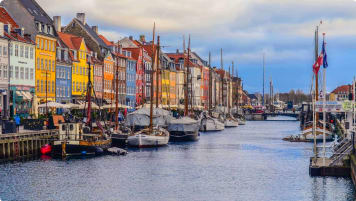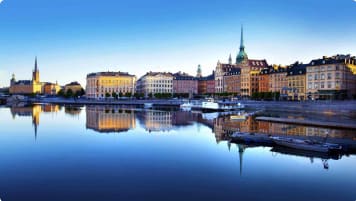Discovering Scandinavia & Viking Denmark for tourists
Discovering Scandinavia Discovering Scandinavia. In this article, we will learn about Denmark with a focus on Viking history, and uncover highlights of Copenhagen. Click here to read our article focusing on Sweden. Small group tours…
10 Nov 19 · 16 mins read
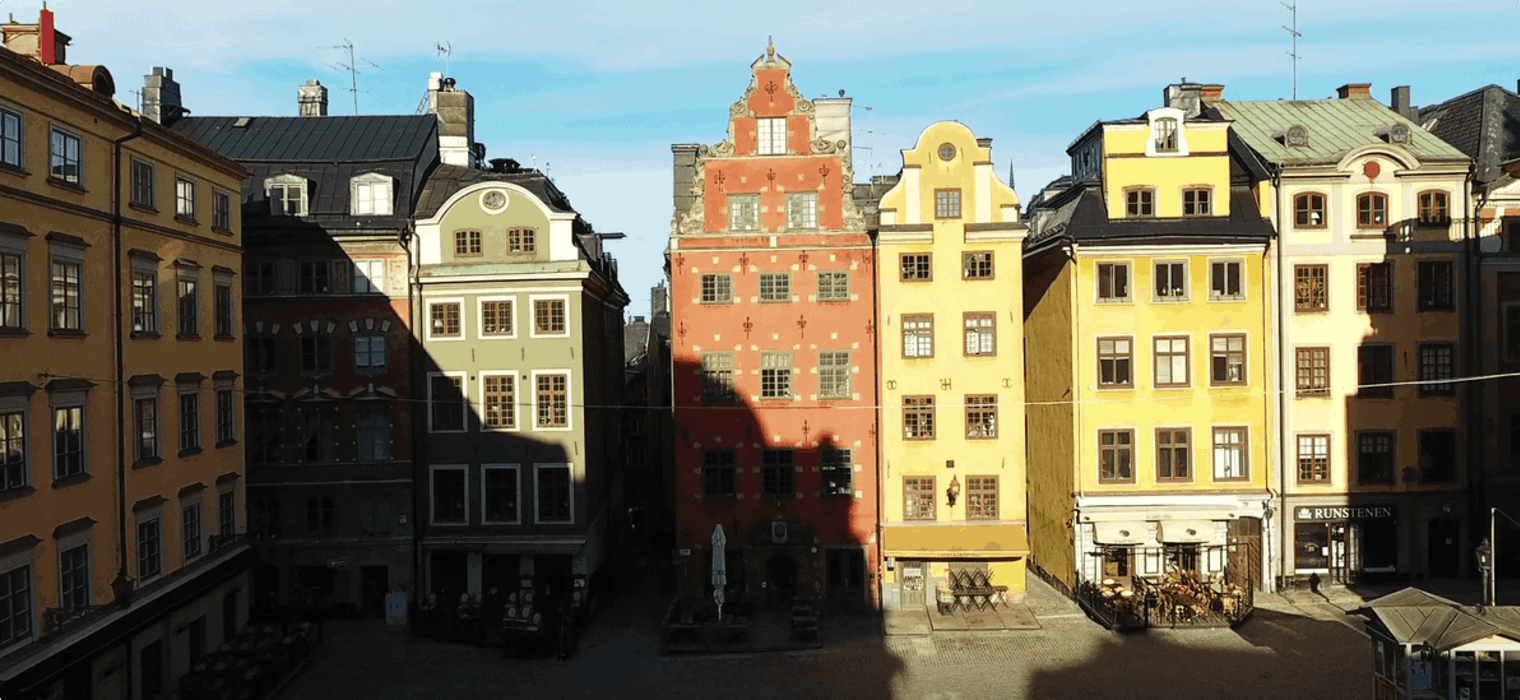
Discovering Scandinavia
Discovering Scandinavia. In this article, we will learn about Denmark with a focus on Viking history, and uncover highlights of Copenhagen. Click here to read our article focusing on Sweden.
Small group tours Scandinavia Itinerary
This is written as a backgrounder of our Scandinavia tours for mature-aged and senior travellers, where we uncover a Viking past in the Scandinavian peninsula. We travel from our centrally located hotel and catch a glimpse of the world’s biggest fjords, and some fabulous scenery, on a journey through the countries of Scandinavia: Norway, Sweden, and Denmark.
In low-lying Denmark, we visit meticulously maintained urban centres, including the vibrant capital of Copenhagen. We continue our sightseeing tour and adventure in Sweden and its capital, Stockholm, now the financial capital of the region. After Sweden, we travel to Norway, famous for its breathtaking Norwegian coastal voyage favoured by tourists. Here, we journey over magnificent mountains and skirt picturesque fjords of Norway to reach Bergen.
This 13-day Scandinavian tours conclude in Norway, a country famed for its rocky coastline. What these Scandinavian countries share in common is natural beauty, and vibrant, unforgettable cultures.
Our Scandinavian tour also visits the Christiansborg Palace (outside visit), housing the Danish Parliament; the Vasa museum, Vigeland Sculpture Park, and the old canal area, Nyhavn, with its picturesque houses and vessels and beautiful landscapes.
The Age of the Vikings
Vikings originated in the region we now know as Scandinavia, from Sweden, Denmark and Norway. Based on historical artefacts, including narrative accounts, the Age of the Vikings is thought to be 700AD to 1100 AD, though more conservative estimates place the first records of activity later in the 8th century.
The Vikings travelled extensively, by both road and sea. They reached as far as North Africa, east Russia, the Middle East, and Asia. Under Leif Erikson, they made it to North America and New Foundland (now Canada). They also colonised parts of present-day Britain, Ireland and Scotland.
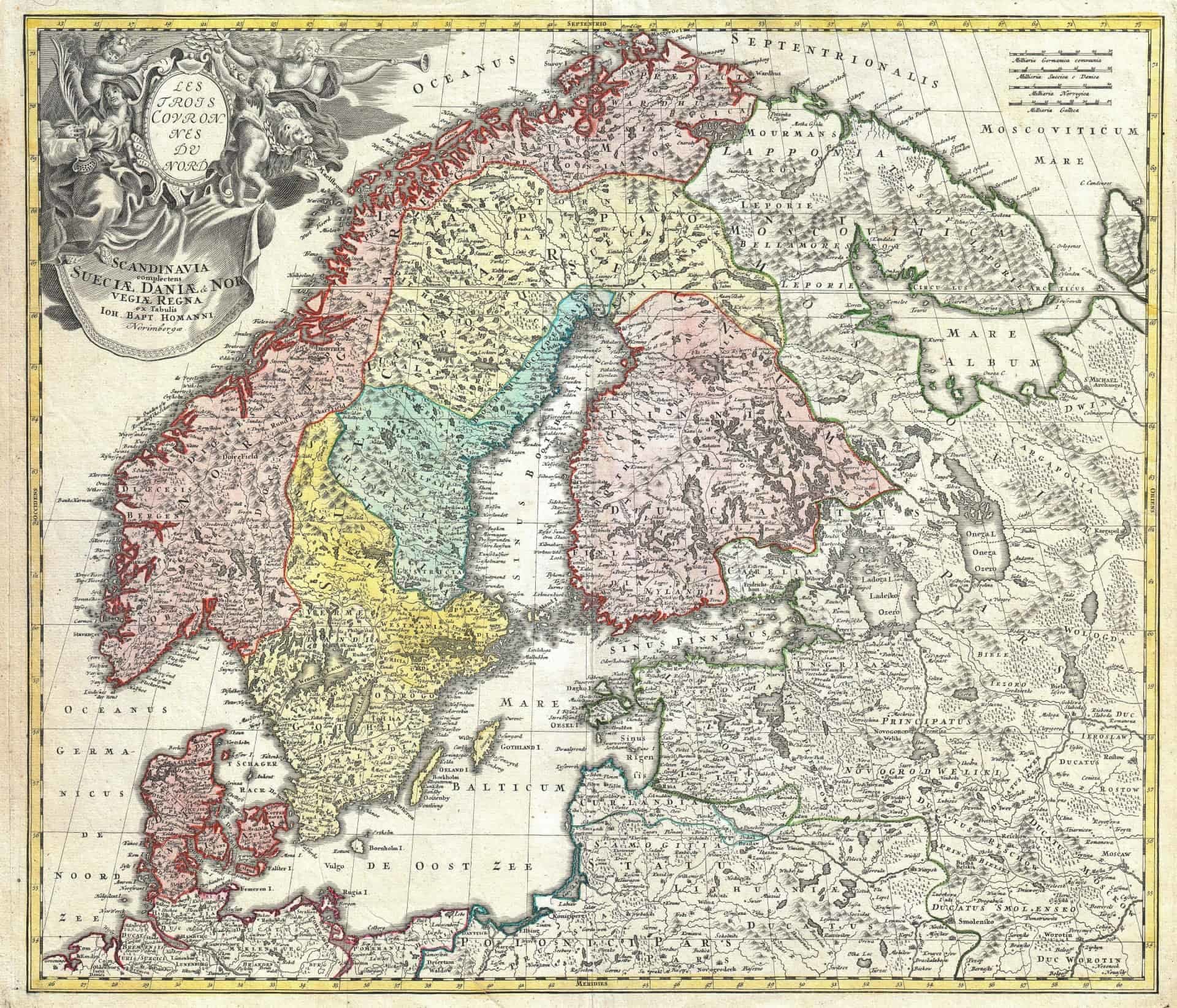
The Vikings and their enemies
Expansion into continental Europe was limited by some powerful foes. The Saxons frequently entered into conflict with the Vikings, prompting the Danes to fortify their defences around Hedeby. But as Charlemagne (or Charles the Great, King of the Franks) violently subdued the Saxons during the Saxon Wars (772 – 804), their fears transferred to the Franks. The Saxons were Christianised and absorbed into the Carolingian Empire. Subsequently, the Vikings constructed further defences to ward off threats.
The Obotrites were Slavic tribes loyal to the Carolingian and Frankish empires. They ruled the south coast of the Baltic Sea, and when the Vikings destroyed Obotrite city Reric in 808 AD, they enslaved the merchants and traders and secured their rule of the Baltic Sea.
Iceland was colonised, beginning in about the ninth century. It’s often thought that the Vikings were the first to settle in Iceland, but sources indicate they drove out Irish monks. A Norwegian chieftain named the capital Reykjavik, which translates to “smoke cave” and likely referenced geothermal steam rising from the earth.
Why the Vikings travelled
- Opinions are divided on this question. Some speculate that the Vikings were revolting against the increasing Christianisation of the time. One expert notes that it is no coincidence that their heightened activity occurred during the reign of Charlemagne.
- Others suggest that the Vikings simply capitalised on moments of weakness, such as England’s suffering from internal divisions.
- Others again, however, resist the temptation to characterise the Vikings as wholly exceptional. They point to raids undertaken by the Jutes, Angles and Saxons as precedents. The Viking raids were the first to be documented in writing from the perspective of witnesses, which contributes to their considerable attention. Then again, Viking raids are understood to have been larger in scale and frequency compared to their predecessors, so perhaps the special attention is warranted.
- Finally, some experts believe that the Vikings simply sought wealth and power. Evidence indicated that they profited from the slave trade. They often captured people and travelled along the so-called “Highway of Slaves” from Scandinavia to Baghdad and Constantinople, in order to trade them.
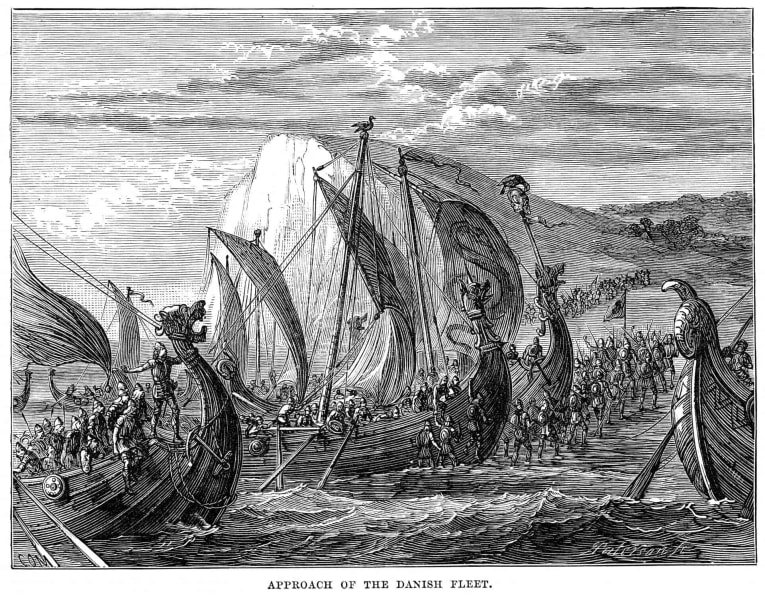
Myths busted
- The helmet: despite the images of popular culture, there is no evidence that Vikings wore horned helmets. In fact, its supposed that such a design would inhibit their seafaring ways.
- The translation of Viking: the Old Norse word Viking is commonly translated as “pirate raid”, but experts warn this is probably not the case. A helpful discussion of the word’s use and misuse can be found here, in this article by by Professor of Viking Studies Judith Jesch.
Denmark Scandianavia
Denmark is the smallest and most southerly of the Scandinavian countries. It is made up of the Jutland Peninsula and over 400 islands, the largest of which is Zealand, where Copenhagen is found. The country is a fascinating mix of pastoral farmland and lively cities, and is rich in medieval churches, Renaissance castles, and fishing villages. The country’s historic and cultural heritage ranges from the Viking Raiders who settled large swathes of England, to colourful medieval kings and queens. The Danish Royal House remains the oldest in Europe and now has an Australian born Crown Princess. The island of Zealand is a contrast of rural pastures and sandy beaches with imposing castles. The country’s lively capital, Copenhagen, is a treasure trove of museums, castles, and churches.
History of Denmark
The earliest archaeological findings in Denmark date back to 130,000-110,000 B.C., during the Eem interglacial period. Habitation seems to have commenced in 12,500 BC, with evidence of agriculture from as far back as 3900 BC.
The Bronze Age

The Nordic Bronze Age occurred between 1800-600 BC. During this time, Scandinavia produced high quality bronze, using imported materials. This was an aristocratic period, with a large gap between the wealthy and poor. The former, as they died, were buried in prominent burial mounds. These mounds or barrows were often over two metres tall. More information can be found on Denmark’s National Museum website. Around 86,000 burial mounds are registered to Denmark, 20,000 of which are attributed to the Bronze Age. Other artefacts from this period include the Sun Chariot, an intricate bronze statue of a horse and disc, placed onto wheels. It was discovered in 1902.
The Roman Iron Age
From 500 BC to 1 AD, the natives began migrating south. In the Roman Iron Age that followed (1-400 AD) trade routes were established with the Roman provinces. There is also evidence of strong Celtic influence in this period.
8th to 10th century
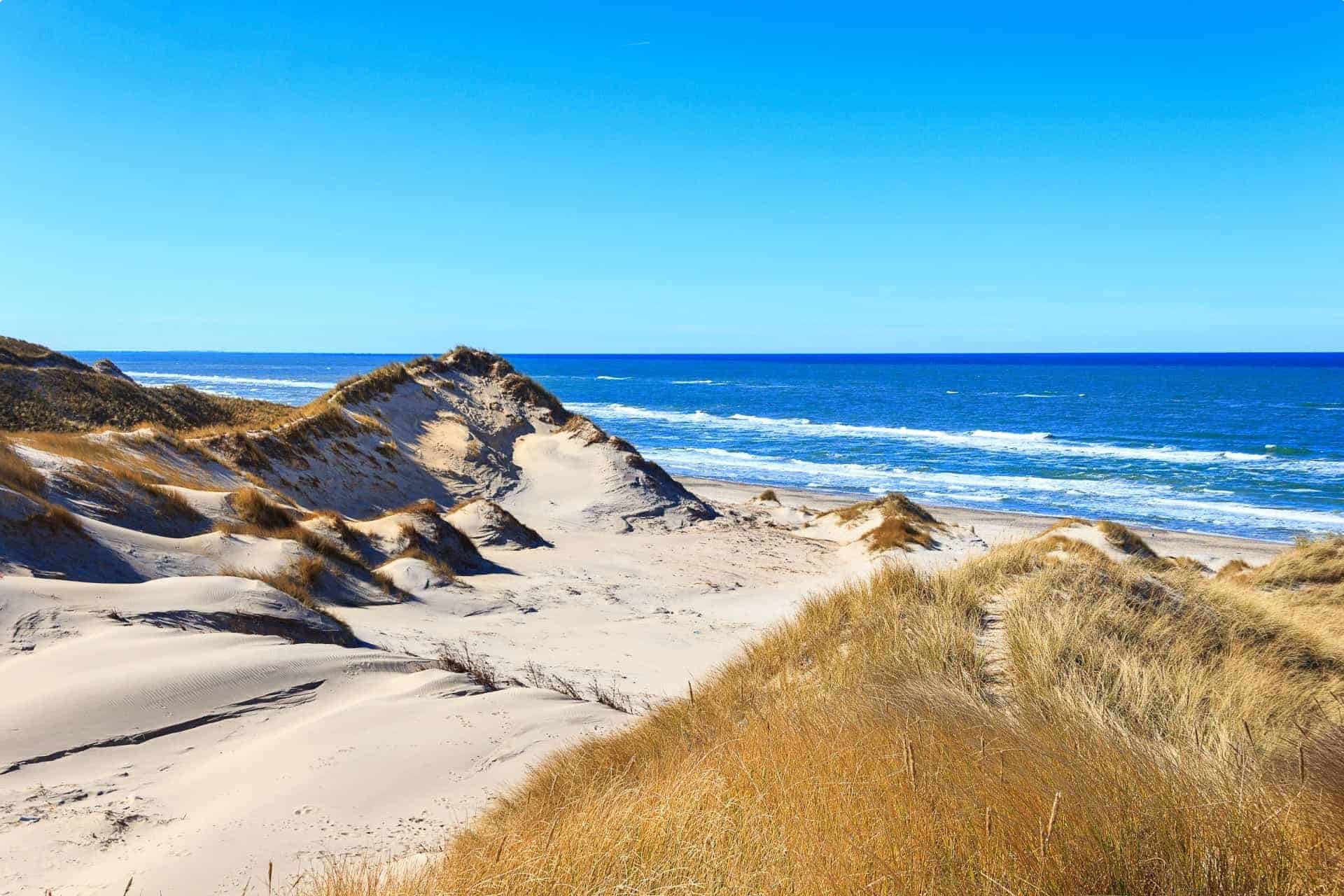
Of course, this is the period of the Vikings. The Danish Vikings were most active in the British Isles and Western Europe. They temporarily conquered and settled parts of England, including Kent by 850. Groups of Danish colonists soon followed, and gained control of northwestern England, a region which became known as Danelaw. Anglo-Saxon king Alfred the Great stepped in, however, and forced the Danes to accept a boundary that bordered his kingdom of Wessex. Danish Vikings also established settlements in Ireland in a series of bloody battles, and France, where they founded Normandy.
Jutland and parts of southern Norway were united under a single king by the early 9th century. The modern day Denmark began to be assembled in the late 9th century, as Norwegian chieftain Hardegon conquered the Jutland peninsula. His son, Gorm the Old is thought to be the origin of the Danish monarchy. He ruled from central Jutland in the early 10th century. He was succeeded by his son, Harald Bluetooth, who went on to rule for 35 years. Harald completed the conquest of Denmark.
The Jelling Stones

In approximately 965, Harald Bluetooth converted the Danes to Christianity. This is taken from the Jelling stones: large, carved runestones that are an important archaeological source. Harald erected a stone in memory of his deceased parents, and its engravings celebrate his conquest of Denmark and Norway, and his religious conversion of the Danes. It is believed that Denmark converted to Christianity to avoid conflict within an increasingly Christianised Europe and Germania. In line with this theory, Harald promptly erected six fortresses around Denmark: evidence of a war-torn age.
Harald’s son Sweyn Forkbeard, and grandsons Harald II and Cnut the Great, were responsible for conquering England.
The Danish Vikings
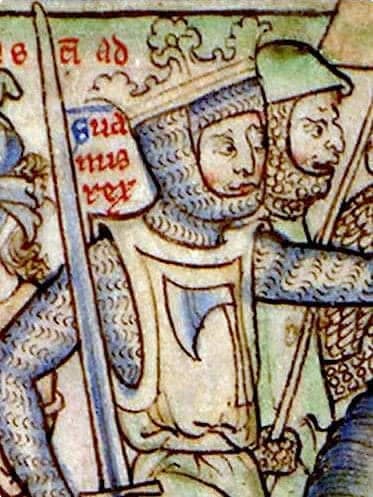
Its thought that Harald and his son, Sweyn did not get along. Some sources suggest that Sweyn was a rebellious pagan, and was an agent in the uprising that saw his father exiled, after which point he soon died. The surviving accounts don’t quite add up, though: one reports that Sweyn was exiled to Scotland for 14 years during his early life, yet he had constructed churches in Denmark within this period of time.
Whatever the circumstances, Sweyn claimed the throne from his father, and ruled as King of Denmark from 986 to 1014. He also ruled Norway from 1000, and gained England in 1013, shortly before his own death. He was the first Danish King of England. While alive, Sweyn fathered many children (to more than one woman), among them Harald, Estrid Svendsdatter and Cnut.
Cnut the Great
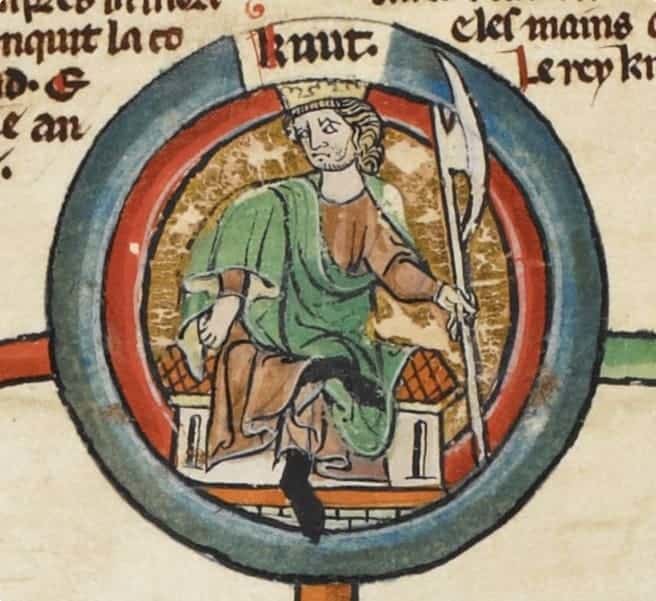
After Sweyn’s death in 1014, he was succeeded as King of Denmark by his son Harald. Meanwhile, Harald’s brother, Danish prince Cnut, was fighting to conquer England. He did so in 1016, in the wake of escalating Viking threat, and years of brutal raids. It’s said that Cnut helped England defend itself against the Vikings, over whom he yielded some control. And in turn, the English helped him in his later successes within Scandinavia.
But meanwhile, his brother King Harald II died in 1018, and Cnut the Great stepped into his place. This brought the crowns of England and Denmark together. In 1028, Cnut further gained the crown of Norway. It’s possible he also held Swedish city Sigtura: coins were struck there that listed him as king, however there is no narrative record to support this. As king, Cnut further developed ties with the Roman church and Christendom. However, some questions still remain over his relations with the church, given his ruthless treatment of rivals and his scandalous romantic relationships.
Cnut married Elfigu and fathered Harald Harefoot and Sweyn Knutsson (who would later rule as King of Norway). He then passed Elfigu over for Emma of Normandy, and had two further children: Harthacnut and Gunhilda (who would go on to marry Henry III, the holy Roman emperor).
Harthacnut and his battle for the crown

When Cnut died in 1035, his first two sons to Elfigu were passed over in favour of Harthacnut. But Harthacnut was busy vying with Magnus the Good for the Norwegian crown. As Magnus claimed reign, Harthacnut was doubly aggrieved: England forsook him for spending too long abroad. His half-brother, Harald Harefoot, had acted as regent of England on Harthacnut’s behalf and by 1037, was generally accepted as King.
Harthacnut’s mother, Emma, had been holding Wessex, but with Harald’s rising power, fled to Bruge in Flanders. Emma had two sons to English King Ethelred the Unready prior to her marriage to Cnut. Cnut became stepfather to Edward and Alfred, after Emma was widowed. Alfred arrived on the coast of Sussex and was en route to London when he was betrayed and captured by Earl Godwin – working for King Harald. Alfred was blinded and later died from his injuries.
While exiled in Bruges, heartbroken Emma plotted to have her son Harthacnut reclaim his throne from Harald. This is eulogised in the Encomium Emmae Reginae, which also describes Harthacnut’s horror at hearing of his half-brother’s murder (at the hands of his other half-brother). According to a later edition of the Encomium, the English made contact with Harthacnut when it became apparent Harald had not long to live. The circumstances of his death in 1040 are unclear, but Harthacnut took the throne peacefully in his place. He did, however, have Harald’s body exhumed from its plot at Westminster Abbey and unceremoniously tossed into the Thames. The body was retrieved and subsequently buried at a church in Westminster, fittingly named St. Clement Danes.
Edward the Confessor and the loss of England
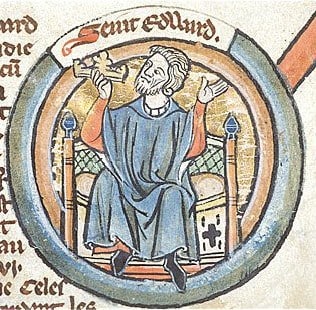
So, Harthacnut had reclaimed his throne in England, and reunited the crowns of England and Denmark as his father had done before him. Magnus the Good maintained the reign of Norway, though. Harthacnut is famously credited for establishing the Danish Royal House. But his own reign was very short-lived: he died just two years later in 1042, throwing the region into further disarray. Harthacnut dropped dead while attending a wedding, having ingested what is assumed to have been an excessive amount of alcohol that brought on a stroke. But some speculate his death may have been plotted – his half-brother (on mother Emma’s side), Edward, stood to benefit from his demise. However there is insufficient evidence, at this stage, to make such a claim.
Edward, with the deceased Alfred, were sons of the late King of England, Ethelred the Unready. Twenty-six years on, and this line would be restored: Edward took Harthacnut’s place as the regions drifted from one another once again. Edward the Confessor ruled England from 1042 till 1066. Norwegian King Magnus the Good stepped in to take Denmark, which he held until 1047. But all the while, he was battling Dane Sweyn II Estridsson for the crown.
The rise of Sweyn II Estridsson

Sweyn had some serious claims to the throne. Remember that Sweyn Forkbeard had a daughter as well as Cnut and Harald II? Estrid Svendsdatter married Danish earl Ulf Thorgilsson. Ulf was killed on Cnut’s orders in 1026 – a murder that may have taken place with Estrid’s consent, given that she remained close to her brother afterwards. Before Ulf’s death, they had a son, Sweyn. Sweyn was educated by the church, and Estrid made donations to the church throughout her life. She is believed to have founded Roskilde Cathedral – Denmark’s first stone church. Estrid supported her son’s struggle for the crown of Denmark.
He received it upon the death of Magnus in c1047. Because Sweyn became King by his mother’s descent, he his known by the matronymic Estridsson, or Estrid’s son. Sweyn reestablished some consistency after a series of rapid changes and considerable upheaval, reigning from 1047 till 1076. But England would never be won back by the Danes. And in Norway, the crown passed to Harald Hadrada, who, though he claimed (with little basis) to have descended from Harthacnut, failed in his attempt at the Danish throne in 1064, and for England, in 1066. The brutal defeat of the Norwegian Vikings by Harold II of England at the Battle of Stamford Bridge marked the end of the Viking era.
Danish pre-history
As author M.K. Lawson has pointed out, Cnut’s daughter Gunhilda married King Henry III, and was to become Queen consort of Germany (in the House of Knytlinga). Had she not perished in Italy before she had a chance to do so, and had her brothers, Harthacnut and Harald, not died within a decade of their father’s death, there may have been a different outcome: a politically unified England and Scandinavia with blood ties to the Holy Roman Empire.
More information on Denmark’s pre-history, and artefacts from the period, check out Denmark’s National Museum
An unequal union
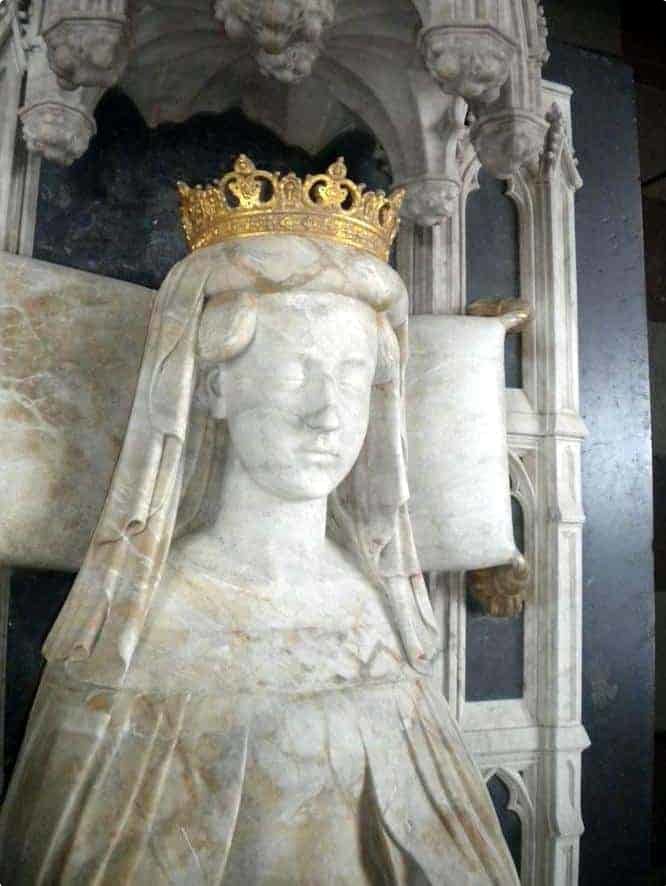
In 1397, Denmark entered into a personal union with Norway and Sweden. Under the Kalmar Union, they were united under Queen Margaret I, and were to be treated as equals. However, even from the beginning, Margaret may not have been as idealistic as it appears. Denmark was treated as the ‘senior’ partner of the union. The next 125 years revolves around this troubled union, with Sweden breaking off and being re-conquered repeatedly.
But on the 17th of June, 1523, Swedish King Gustav Vasa conquered the city of Stockholm. He is now known as the “Father of Sweden”. Stay tuned for our upcoming article on Swedish history for more information on the Swedish War of Liberation.
The conversion to Lutheranism
The Protestant Reformation came to Scandinavia in the 1530s, and following the Count’s Feud civil war, Denmark converted to Lutheranism in 1536. Later that year, Denmark entered into a union with Norway.
The Thirty Years War
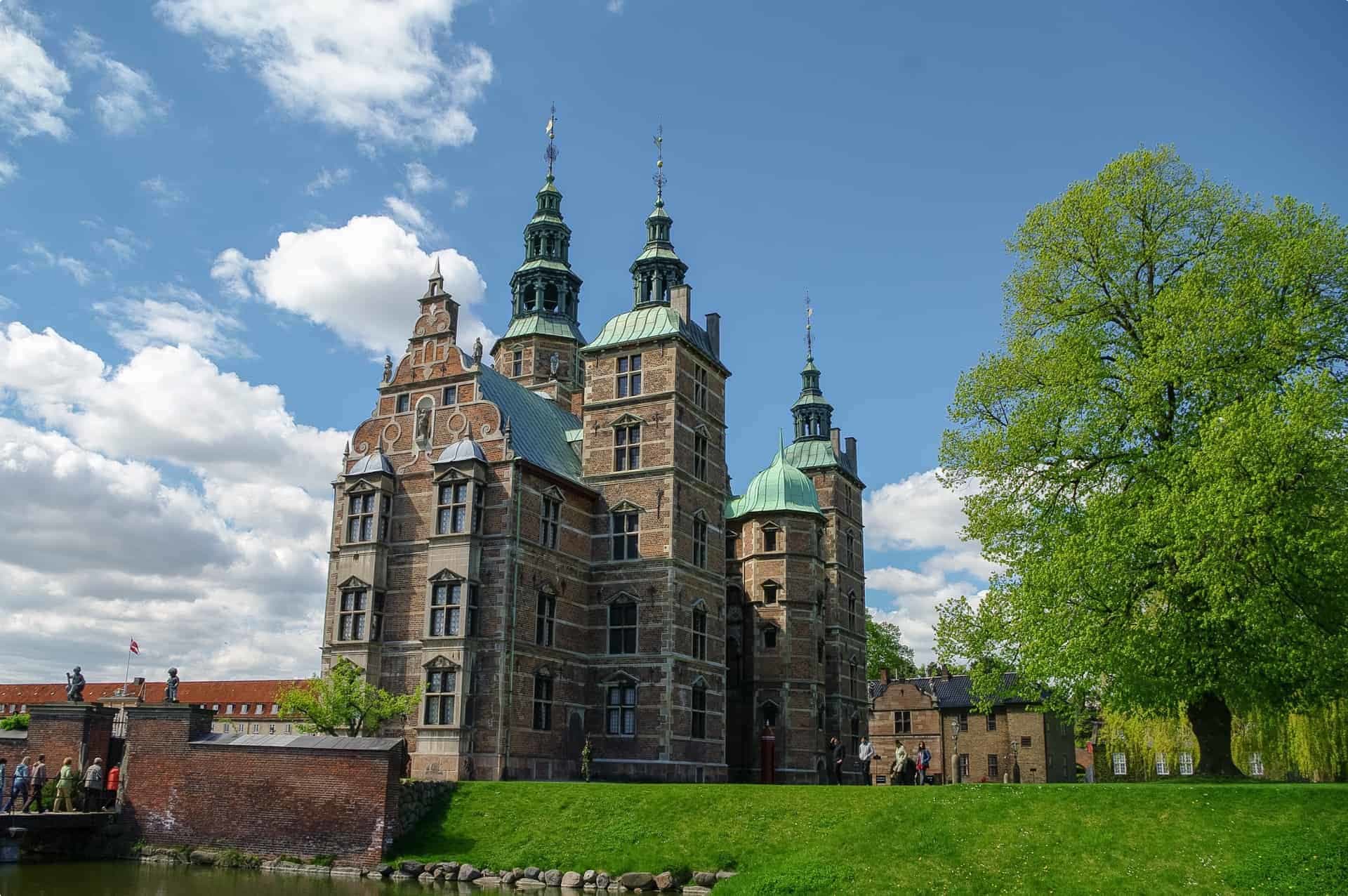
In the Thirty Years War (1618-1648), Danish King Christian tried to become the leader of the Lutheran states in Germany. But he suffered a crushing defeat at the Battle of Lutter. The result was that the Catholic army under Albrecth was able to invade, occupy and pillage Jutland, forcing Denmark to withdraw from the war.
Denmark managed to avoid territorial concessions, but Gustavas Adolphus’ intervention in Germany was seen as a sign that the military power of Sweden was on the rise, while Denmark’s influence in the region was declining.
Sure enough, Swedish armies invaded Jutland in 1634 and claimed Skane in 1644. This resulted in a drop in agricultural production and subsequent shortage of capital. As the plague also ravaged the land between 1647 and 1651, Denmark’s population fell by 20 per cent. In the 1645 Treaty of Bromsebro, Denmark surrendered Halland, Gotland, the last parts of Danish Estonia, and several provinces in Norway.
War on Sweden
In 1657, King Frederik III declared war on Sweden and marched on Bremen-Verden. This led to a massive Danish defeat and the armies of King Charles X Gustav of Sweden conquered Jutland, Funen and much of Zealand before signing the Peace of Roskilde in February 1658 which gave Sweden control of Skane, Blekinge, Trondelag and the Island of Bornholm. Charles X Gustav quickly regretted not having destroyed Denmark completely and in August 1658 he began a two-year long siege of Copenhagen but failed to take the capital. In the following peace settlement, Denmark managed to maintain its independence and regain control of Trondelag and Bornholm.
Denmark tried to regain control of Skane in the Scanian War (1675-79) but this attempt was a failure. Following the Great Northern War (1700-21), Denmark managed to restore control of the parts of Schleswig and Holstein ruled by the house of the Holstein-Gottorp in 1721 and 1773 respectively.
The Napoleonic Wars
In the Napoleonic Wars, Denmark originally tried to pursue a policy of neutrality and trade with both France and United Kingdom and joined the League of Armed Neutrality with Russia, Sweden and Prussia. The British considered this a hostile act and attacked Copenhagen in both 1801 and 1807; in one case carrying off the Danish fleet, in the other, burning large parts of the Danish capital. This led to the so-called Danish-British Gunboat War. But the British control of the waterways between Denmark and Norway proved disastrous to the union’s economy and in 1813, Denmark-Norway went bankrupt.
The Danish-Norwegian union was dissolved by the Treaty of Kiel in 1814. Norway entered a new union with Sweden which lasted until 1905. Denmark kept the colonies of Iceland, Faroe Islands and Greenland. Apart from the Nordic colonies, Denmark ruled over Danish India (Tranquebar in India) from 1620 to 1869, the Danish Gold Coast (Ghana) from 1658 to 1850, and the Danish West Indies (the U.S. Virgin Islands) from 1671 to 1917.

Danish Royal Family
The Danish Monarchy is one of the oldest in the world. It has existed for over 1000 years. The Royal Family enjoys remarkably high approval ratings in Denmark. Members of the family include
-
HM Queen Margrethe II and HRH Prince Henrik of Denmark
-
Crown Prince Frederik and (the Australian) Crown Princess Mary
-
Prince Christian of Denmark
-
Princess Isabella of Denmark
-
Prince Vincent of Denmark
-
Princess Josephine of Denmark
This link leads to a description of the succession to the throne.
Amalienborg Palace
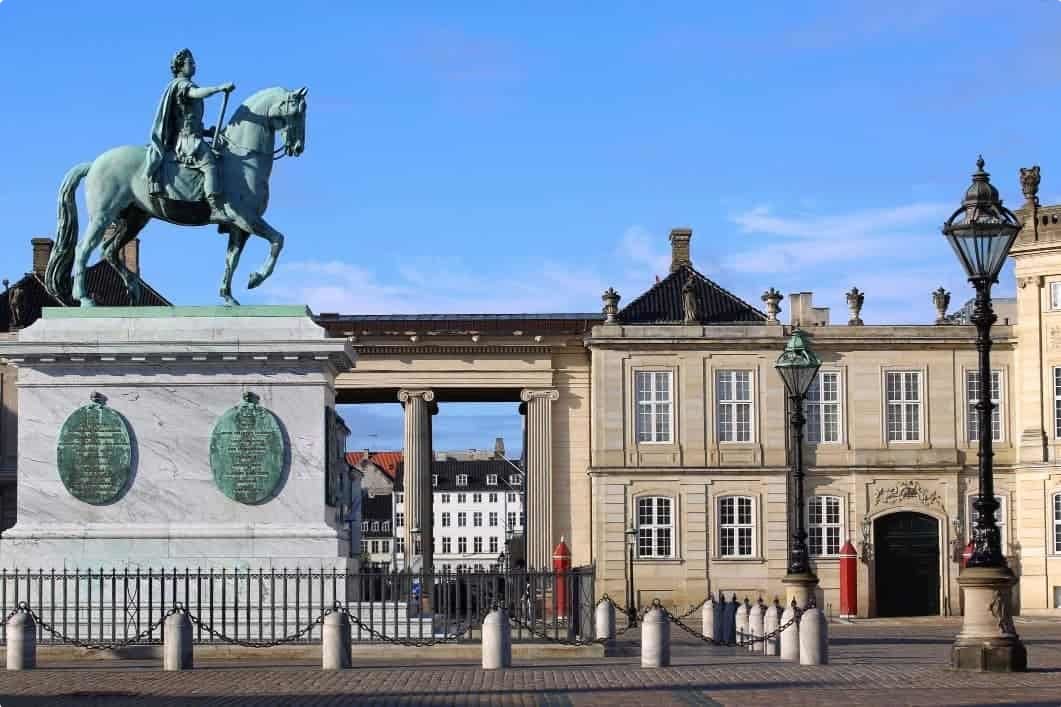
This complex of four palaces is the Royal Couple’s winter residence. It was constructed by Frederik V on the 300th anniversary of the coronation of Christian I. The site was given to four nobleman: A.G. Moltke, Christian Frederik Levetzau, Joachim Brockdorf and Severin Løvenskiold. These men built four identical palaces under the design of the court architect. They are built around an octagon-shaped courtyard, with an equestrian sculpture of Frederik V at the centre. Amalienborg became the royal residence after Christianborg Palace burned down in 1974.
Rosenborg Castle
This castle was the favoured summer residence of Christian IV. It was built between 1606 and 1634, and sits just outside of bustling Copenhagen. After Christian IV’s death, King Frederik III inherited the Castle. He, along with his queen, Sophie Amalie, undertook modernisation works to the construction. Frederik IV was the last king to use Rosenborg Castle as a place of residence. After 1720, Frederiksborg Palace became the preferred residence. Rosenborg Castle became the site of many collected art treatures, including items from deceased royalty estates. This is what inspired the idea of the site becoming a museum. The Royal Danish Collection was established in 1833, and opened to the public in 1838. More information on the fascinating Rosenborg Castle can be found here.
Statue of the Little Mermaid

The Little Mermaid statue is based on the fairy tale by Danish author Hans Christian Andersen. Cast in bronze, it sits atop a rock by the waterside in Copenhagen. It is around 1.25 metres tall and weighs 175 kilograms. The statue was commissioned by Carl Jacobsen, who was the son of the founder of Carlsberg breweries. He was fascinated by a ballet at the Royal Theatre and asked the ballerina, Ellen Price, to model for the statue. The head is modelled after her, but the body was inspired by Jacobsen’s wife, since Price refused to pose nude. Unveiled in 1913, it has since become a major tourist attraction. It is said to be Denmark’s most photographed statue.
Part of its renown owes to its’ history of vandalism. The unimposing statue has been decapitated twice – in 1964 and 1998, and a third attempt in 1990 left a deep cut in the neck. In 1964, a new head had to be made. But it was anonymously returned following the 1998 incident. The statue has had its arm sawn off (1984), holes blasted into the wrist and knee by explosives (2003), draped in a burqa (2004, 2007), and has been drenched in various colours of paint throughout its lifetime.
Denmark’s official tourism site features a fun infographic on the statue’s “tumultuous existence”.
Must see in Copenhagen
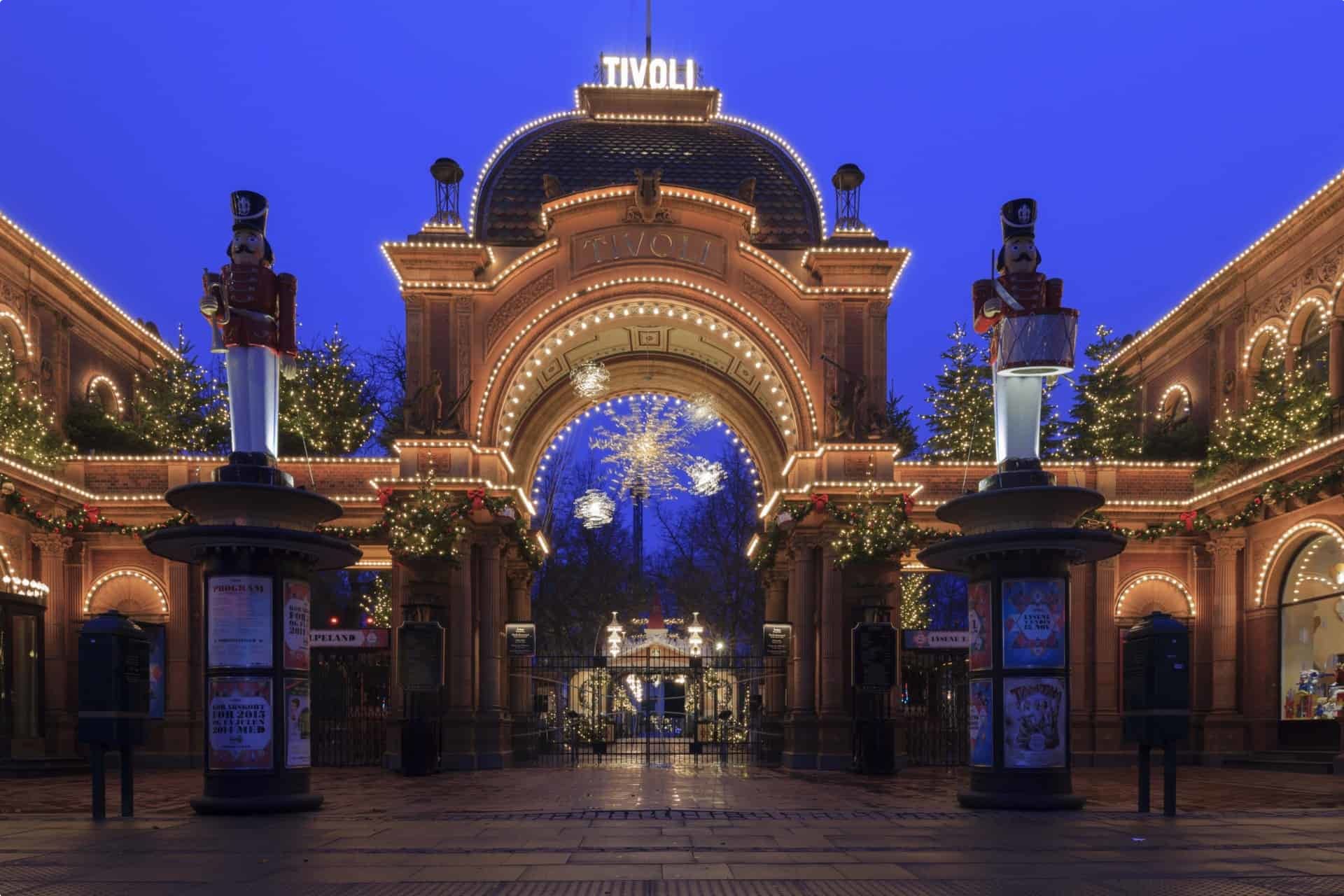
1. City Hall Square
City Hall is the headquarters of Copenhagen’s municipal council, as well as the Lord Mayor. Located in central Copenhagen, it is Romantic in its architectural style. Designer Martin Nyrop was reportedly inspired by the Siena City Hall. The building features a slim clock tower and a statue of 12th century archbishop Absalon. These two structures make City Hall one of the tallest buildings in this relatively low-levelled city. Inaugurated in 1905, it is still in use today. And, positioned at the beginning of popular pedestrian shopping strip Stroget, it is well worth a visit on your Danish tour.
2. Tivoli Gardens
The impressive Tivoli Gardens is the world’s second oldest amusement park. (The oldest amusement park is also located in Denmark, in the nearby city of Klampenborg.) Tivoli Gardens offocially opened on the 15th of August, 1843. Offering a slice of 19th century history, and plenty of fun, it will delight visitors both young and old.
3. New Carlsberg Glyptotheque
This art museum houses the collection of Carl Jacobsen (of Carlsberg brewery fame). It is primarily a sculpture museum, but is equally impressive for its paintings. These include Impressionist works, along with those from the Dutch Golden Age. Carl Jacobsen was a dedicated art collector. As his “house museum” grew, particularly in sculptures that spilled out into his villa garden, new premises became necessary. He donated his collection to the Danish State in 1888, on the condition they provide them safe-keeping. The museum was built nearby Tivoli Gardens, and Jacobsen was given the honour of naming it.
4. The National Museum
Denmark’s largest cultural museum makes quite the impression. It houses historic artefacts from across the world, and will take you on a journey through time.

5. Old Stock Exchange
This is one of the oldest buildings in Copenhagen. It features a spire styled in four intertwined dragon tails topped with three crowns. These crowns symbolise the Scandinavian Empire of Denmark, Sweden and Norway.
6. Naval Church
The Church of Holmen (in Danish, Holmen Kirke) was first built in 1563, as a metals workshop for the production of anchors. Christian IV converted it to a naval church around 1617 in response to the influx of navy personnel to the area. It achieved international renown for hosting the wedding of Queen Margaret II to Prince Henrik in 1967.
7. King’s New Square
Despite its name, this is actually a central old square home to the Royal Theatre, among other institutions. The square was officially constructed in 1908, but paved with cobblestones in 1670. Copenhagen’s oldest equestrian statue stands in King’s New Square – it dates from 1688.
8. Nyhavn canal area.
This colourful, water-front entertainment area is the perfect place to take in the Danish sunshine.
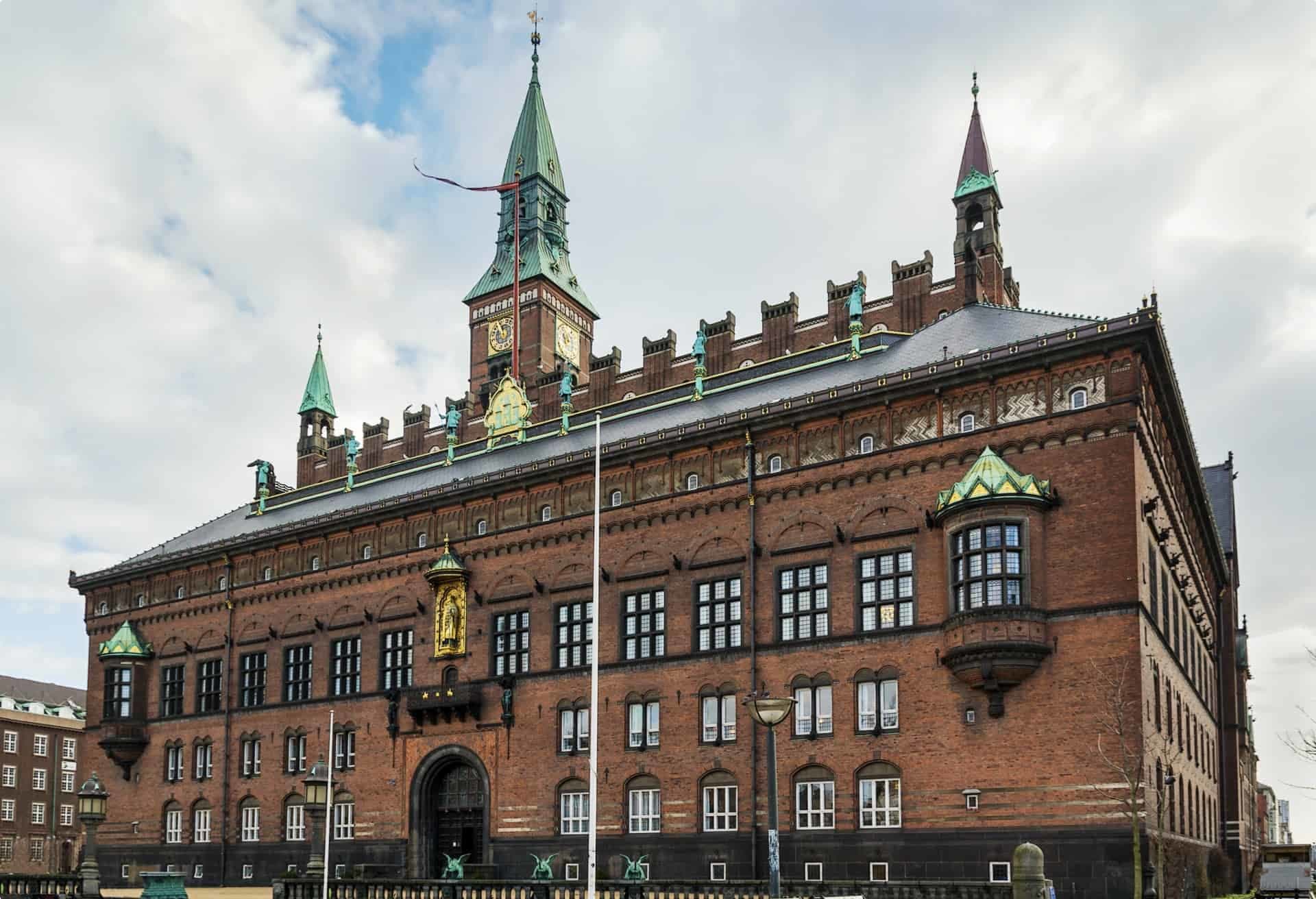
Highlights of Scandinavia
The Scandinavia tours are small group programs suitable for senior and mature-aged couples or solo travellers.
Odyssey Traveller offers more than 140 scheduled small group tours to people from all over the world. Our travellers and programme participants share our passion for a style of travel experience that puts focus on exploring and learning. The 13-day Scandinavian tours for mature travellers is offered in June each year. Copenhagen also features in our 21-day Scandinavian Design small group tour.
For more details about the Scandinavia tours, follow this link to the tour page. If you’re keen to experience this tour, please call or send an email. Or, to book, simply fill in the form on the right hand side of the tour page.
Originally published on November 20, 2017
Updated November 10, 2019
Related Tours
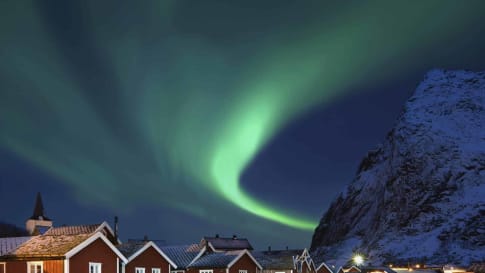
10 days
Oct, JanNorthern Lights Small Group tour | Visit Norway and Finland
Visiting Finland, Norway
Odyssey's small group tour following the Northern Lights allows you to experience serene snow-covered Arctic landscapes. Throughout our journey guides and specialists will outline the history of this stark region and the nature of the peoples who wrested their living from it. A unique opportunity to view this natural phenomenon travelling as part of a small group.
From A$9,625 AUD
View Tour
21 days
SepScandinavian Design Small Group Tour: Denmark, Sweden and Finland
Visiting Denmark, Finland
Denmark, Sweden and Finland realised that the only way to remain competitive on the world stage was through the value of superior design. Travelling with like-minded people on our small group tour you will explore the cities and towns where those high quality products, appreciated around the world, are created including hygge.
From A$16,685 AUD
View Tour
20 days
Aug, MayTour of Denmark's Culture & History
Visiting Denmark
Experience group travel for couples and single travellers to Denmark. This European tour provides a travel experience based around key destinations and itineraries that provide authentic experiences in Denmark .A single supplement applies for solo travellers.
From A$15,895 AUD
View Tour